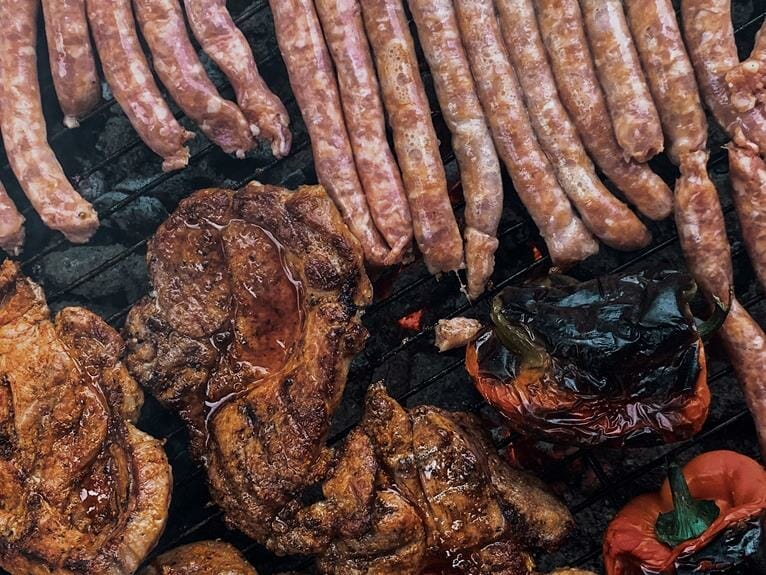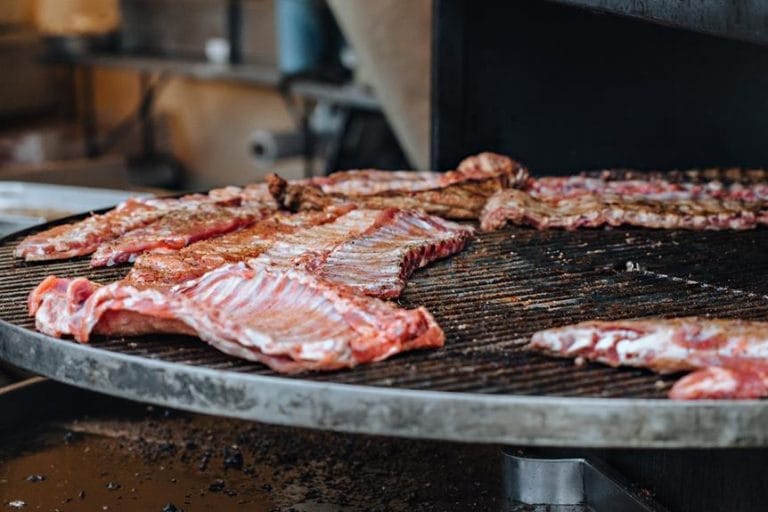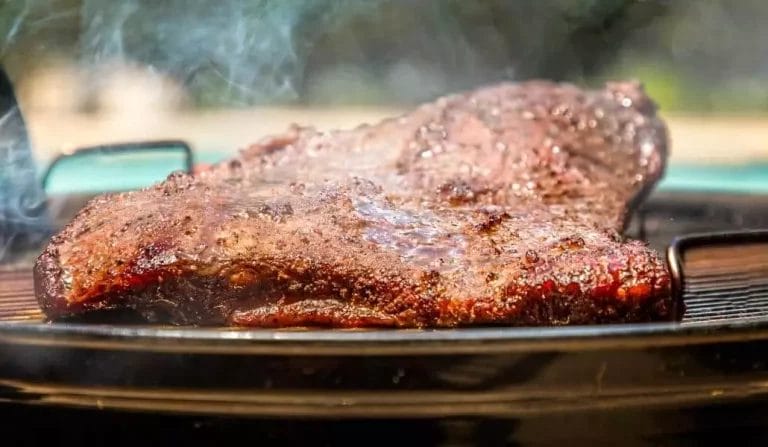5 Steps To Perfectly Trimming A Pork Shoulder
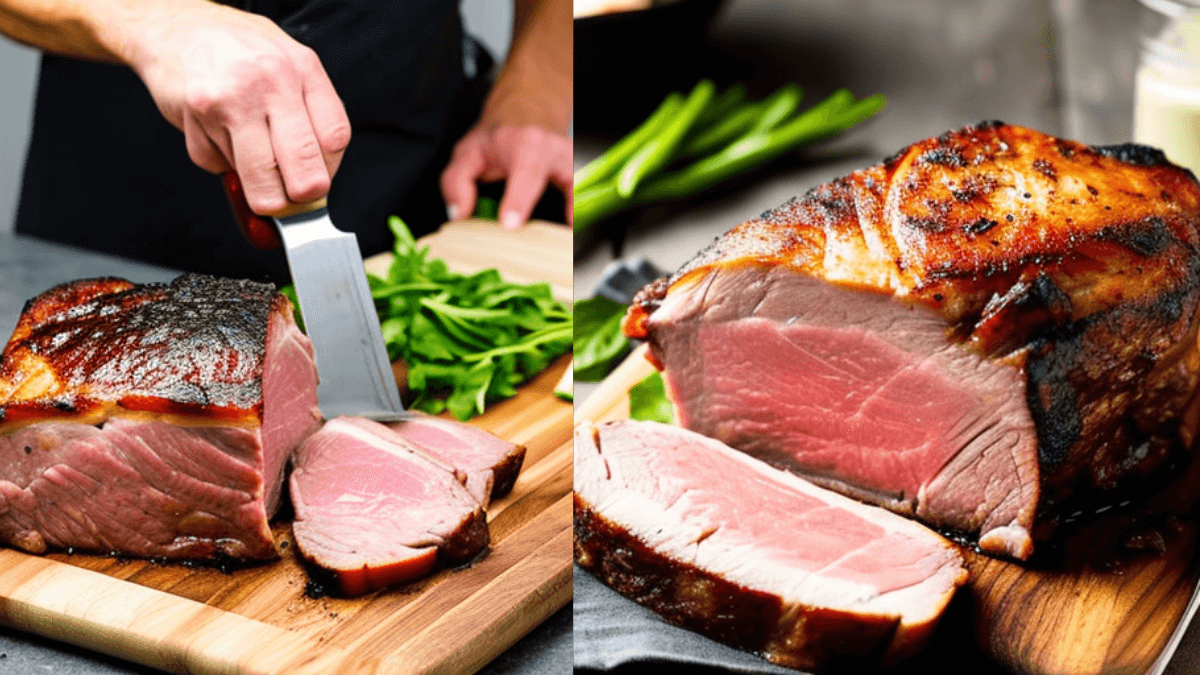
Have you ever wished for a perfectly trimming a pork shoulder? We all know that cooking is an art, and we can appreciate the effort it requires to achieve culinary perfection. But what if I told you there was a way to make this dream come true without any stress or messiness? With just five simple steps, you, too, can learn how to trim your pork shoulder like a professional chef!
Surprise yourself with the delicious results of following these easy instructions. Whether you’re looking to impress guests at a dinner party or simply upgrade your home-cooked meals, our guide below will walk you through every step needed to give your pork shoulder that perfect finish. Ready? Let’s get started!
Irony alert: In case you’re new to cooking, don’t worry – it doesn’t require years of experience in the kitchen. Our five steps are tailored for everyone, from beginner chefs trying their hand at something new to seasoned cooks wanting more control over their dishes. All you need is time and patience – plus maybe a few tips from us on the side – and soon enough, that succulent glaze of roasted pork will be sitting right in front of you!

Gather Necessary Tools
The theory that a perfect pork shoulder trim requires the right tools can be tested and proven in the kitchen. When it comes to selecting these tools, there are some key elements to consider. A good quality knife is essential for any cut of meat, especially when looking to create uniform slices with an even texture.
For a pork shoulder, you should look for a high-carbon steel blade that has enough weight behind it to slice through thicker cuts of meat like bone or fat without too much effort. You will also need other equipment, such as tongs, cutting boards, thermometers, and food scales, to ensure proper conformation for your pork shoulder before trimming begins.
When preparing your cut of pork shoulder for trimming, controlling temperature and moisture content are two important factors that must not be overlooked. Heat affects both the tenderness and flavor of the finished product; therefore, preheating the oven or grill up to 325°F (163°C) prior to cooking is advisable.
Similarly, keeping your work surface clean and dry will help prevent contamination from raw meat juices while allowing greater control over how quickly fat renders during preparation.
With all these necessary tools at hand
– plus patience and skill
– anyone can confidently trim their own perfect piece of pork shoulder!
Remove Skin And Fat From the Shoulder
“The devil is in the details,” and that couldn’t be truer when it comes to trimming a pork shoulder. With patience and skill, you can turn an ordinary cut of meat into something extraordinary! In this step, we’ll learn how to remove skin and fat from the shoulder for perfect results.
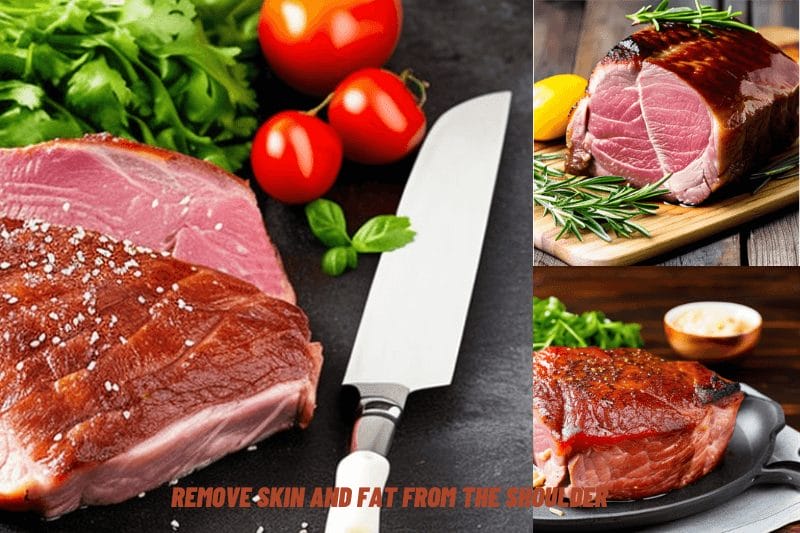
Using a sharp knife, start at one end of the shoulder blade bone and run your blade parallel to the bone while also following any sections of skin or fat around it. This will separate the fat from the muscle without taking too much off with it; however, if there are large pockets of fat on top or along either side of the shoulder, take extra care to remove them as well. As you move along, use short strokes to get closer to the bone so that you don’t accidentally cut away too much precious lean meat.
TIP: Use a boning knife or similarly-shaped blade for precision control while trimming – this will help ensure you have enough room between cuts for even cooking later on. Plus, its curved shape allows you great access near joints and edges that other blades may not reach!
Separate Bone From Meat
As you move onto the next step of trimming a pork shoulder, it’s time to separate the bone from the meat. This process can feel intimidating when faced with such an immense piece of protein; however, once you get started, it’ll be second nature in no time.
Picture yourself as a master butcher and take out your sharpest knife – this is where you shine! Carefully cut away at the fat and connective tissue between the bone and muscle until they are totally separated. If done well, it’s like slicing through butter – smooth and effortless. Letting your creativity flow freely while making precise incisions will leave you feeling satisfied like an artist who has just finished their masterpiece – only your canvas is flesh instead of paper.
Now that the bone is removed, there’s one more task before moving on to cutting into slices: removing any residual fat or gristle which may remain on the pieces of meat. To do so, use small kitchen shears to carefully snip off any excess bits that don’t give way easily under pressure from your fingers alone. With all these steps complete, you have successfully prepared to slice up your succulent pork shoulder into perfect portions!
Cut Shoulder Into Slices trimming a pork shoulder
Do you want to know the secret of how to perfectly trim a pork shoulder? It’s simple: just cut it into slices! That’s right, all you need is an incredibly sharp knife and some magical slicing skills. You can be sure that with this technique, your pork will turn out to look like something from a Michelin-starred restaurant.
It may sound too good to be true, but trust us – this really works! All you have to do is take the meat off the bone and make thin slices around one inch thick. This will ensure that each slice has enough fat, so they remain juicy while cooking, as well as minimize waste as no parts of the shoulder are left uncooked. Plus, cutting it into smaller pieces makes it easier to season and marinate so your dish tastes even better!
This method also allows for greater control over cooking time since thinner slices require less time in the oven or on the stovetop. And once everything is cooked through, you’ll end up with delicious tender morsels that melt in your mouth – what more could you ask for? So if you’re ready to get started on perfecting your pork shoulder trimming technique, then grab your knife (and maybe an apron) and start slicing away!
Prepare The Blanching Solution
Take a deep breath and be prepared to enter the realm of culinary enlightenment. Prepare the blanching solution for your pork shoulder slices with the same care you would use if you were curing an ancient, sacred relic. Gather together two liters of water, five tablespoons of sea salt, three bay leaves, and one teaspoon each of thyme and black pepper in a large pot. Place over medium heat, occasionally stirring, until all ingredients are completely dissolved. With this simple task complete, you have taken the first steps towards perfectly trimming a pork shoulder!
Now comes the time to subtly balance flavors while allowing enough space to take advantage of other seasoning options later on down the road. To do so, add four cloves of garlic that have been cut into thin slivers; simmer for additional fifteen minutes before adding another tablespoon of sea salt and one tablespoon of sugar. Simmer once more for ten minutes before removing from heat – oops! Don’t forget to save some asparagus spears for later!
Ah, yes – your work here is done! But don’t worry about having any leftovers because there’s always something else on the horizon: next up, we’ll take our delicious blanching solution and Blanche those juicy cuts of meat…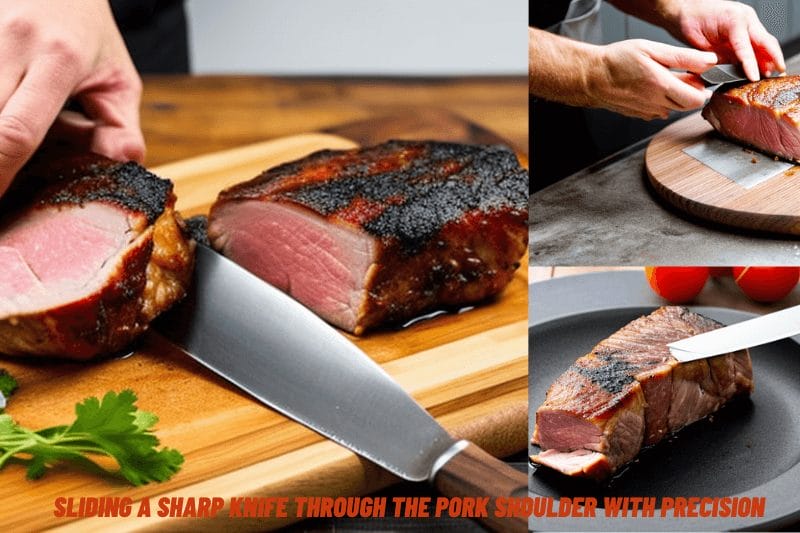
Blanch Shoulder Slices
Sliding a sharp knife through the pork shoulder with precision, creating perfect slices is an art. It requires skillful hands and good eyesight to obtain symmetrical slices of meat that are thin enough to blanch. Once these prerequisites have been met, one can move on to the next step in their culinary journey; blanching the sliced pieces of pork shoulder.
This process starts by boiling some water – how much depends upon how many slices you plan to blanch– adding salt and other flavorings according to your preference before carefully submerging each slice into the hot liquid for just long enough to cook it through without making it soggy or rubbery. This helps keep all its goodness locked inside as well as maintain its texture when cooked further later on.
TIP: To check if the pork has properly cooked through, pierce a piece with a fork and see if there’s still pinkness around the center. If so, add a few more minutes until fully cooked!
Remove Excess Fat From the Shoulder
Trimming a pork shoulder correctly is essential for achieving the ideal flavor and texture. According to the National Pork Board, Americans consume an average of 53 pounds of pork per person each year! That’s quite a lot of delicious piggy goodness!
When trimming your pork shoulder, it’s important to remove any excess fat from the meat. Excess fat can cause uneven cooking or result in tough textures due to its low melting point. To do this properly, you’ll need a sharp chef’s knife and access to running cold water. Start by lightly scoring around any large sections of fat with your knife blade – just enough so that you can pull it away easily with your hands. Then use the flat side of your knife to scrape off any remaining thin layers of fat until they’re gone completely. If needed, rinse the meat under cold water while wiping it down thoroughly with paper towels afterward. This will ensure no small pieces are left behind, which could lead to rubbery results later on when cooked.
The process may seem tedious at first but removing excess fat is key for preparing the perfect slice of pork shoulder bliss! It also ensures maximum flavor absorption during cooking as well as reduces shrinkage caused by evaporative loss due to heat exposure.
With that out of the way, we can now move on to trimming away connective tissue from our juicy cut of meat – let’s get started!
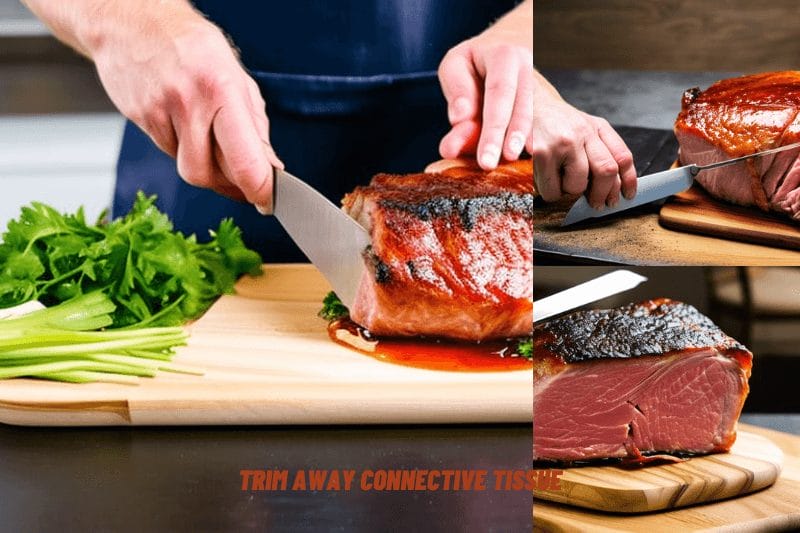
Trim Away Connective Tissue
Trimming away connective tissue from a pork shoulder is like untangling the strings of a marionette. Every cut brings it closer to its perfect form, whether you’re preparing for a meal or an art installation.
Using sharp kitchen shears and a boning knife, start by snipping off any tough cartilage or silverskin that covers the meat. This may take some time, but it’s worth every minute as this will allow your flavors to penetrate during cooking and make sure each bite is tender and juicy. As you go along, try cutting into small sections so that they can be slowly pulled away more easily; think of it like peeling away layers of an onion – starting at the outside layer first before getting deeper inside with subsequent cuts.
Once all the hard pieces have been removed, use your knife to score any larger chunks still attached to the roast. This helps separate them further, ensuring there are no lumps or bumps left when serving later on! With patience and precision, you’ll soon be able to shape the shoulder into its desired form before finally moving on to smaller portions.
Cut Meat Into Smaller Portions
Nothing quite compares to the sight of perfectly cut pork shoulder. In one fluid motion, we can take a large piece of meat and transform it into bite-sized portions that will tantalize any audience. To achieve such precision, follow these steps for cutting your pork shoulder.
Let’s start by using our mind’s eye to envision what lies ahead. Think of each slice as a journey from point A – where it starts – to its destination – where you want it to end up! As if carving through butter, use a knife to make straight cuts across the grain of the meat so that each portion is uniform in size and shape.
To help with organization, here are three tips:
- Use a sharp knife when slicing so you don’t tear or shred the meat;
- Place your hand flat on top of the pork shoulder while you’re slicing in order to create an even surface for more accurate cuts;
- Cut against the grain of the pork shoulder to ensure tenderness once cooked.
So there you have it: easy techniques that’ll leave your kitchen smelling like a five-star restaurant after every meal! Now go forth and let your inner chef shine as you prepare juicy and succulent slices of deliciousness fit for feasting upon! Ready for the next step? Let’s skewer them up!
Skewer The Meat
Are you looking to create the perfect pork shoulder? Skewering your meat is an essential step in ensuring that it cooks evenly.
The key to successful skewering is to use a long skewer so that multiple pieces of meat can be strung onto each one. This will ensure even cooking, as the heat can penetrate all parts of the meat simultaneously. Place the pieces on the skewer with plenty of space between them and make sure they are firmly secured around their length. With this technique, you’ll be able to get a nicely browned surface without having any overcooked or undercooked sections.
When you’re finished skewering, you should have several bundles that look like flat sausages! Now that your pork shoulder has been cut into smaller portions and correctly arranged on skewers, it’s time for another critical step: roasting the pork shoulder until golden perfection.
Roast The Pork Shoulder
Cooking a pork shoulder is like playing the perfect piece of music. It takes time and patience, as well as knowledge and finesse, to achieve the optimum outcome. Roasting your meat is one of the most important steps in this process – it’s almost like tuning up an instrument before you start to play.
The goal when roasting any type of meat is for its natural juices to seep out into the cooking tray below, keeping all the flavor locked inside while also providing some delicious gravy at the end. To do this, you’ll need to set your oven temperature somewhere between 275F-300F (135C-150C). Place the skewered pork shoulder onto a baking sheet lined with aluminum foil, then insert a thermometer into the thickest part of the roast. When it reaches 165F (74C) internally, that means it’s done!
When removing from the oven, make sure to grab two potholders, so you don’t burn yourself on hot handles or metal trays. Then take a moment to savor the aromas released during roasting—the sweet smells of caramelized onions mixed with herbs and spices will tantalize your taste buds in anticipation for what’s coming next: preparing glaze for basting.
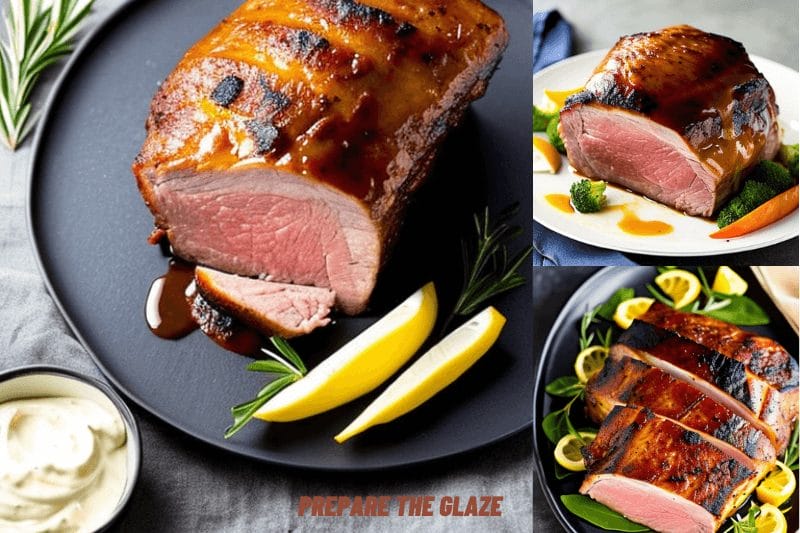
Prepare The Glaze
A perfectly trimmed pork shoulder is an exquisite sight to behold, and a glaze adds the perfect finishing touch. Preparing it requires skill and patience, but with some simple tips, you can easily master this technique.
Before we move on to basting our delicious roast, let’s take a few moments to consider how best to prepare our delectable glaze. It is important to choose ingredients that are of high quality; freshness makes all the difference in your final dish! If you’re looking for inspiration, there are plenty of recipes available online or from your local butcher shop.
When you have gathered all the necessary components for your glaze, simply combine them together into a smooth paste. You may also wish to add a pinch of herbs or spices for additional flavor – just be sure not to adjust portions so as not to overpower the taste of your meat. Leave aside until needed later in the cooking process.
The result? A sweet-tart topping that will tantalize tastebuds and leave mouths watering – an ideal accompaniment for any succulent pork shoulder! With our glaze now prepared, we’re ready to move on to the next step: basting our roasted delight…
Baste The Pork Shoulder
When preparing a pork shoulder, the basting process is incredibly important for achieving the perfect flavor and juicy texture. Take it from Jessie, who’s been cooking up award-winning barbecues in Texas for decades: if you want to impress your guests with melt-in-your-mouth pork shoulder slices, make sure not to skimp on the basting!
Basting involves continually brushing or spooning liquid over the meat as it cooks. This helps keep the roast moist while also infusing flavor into each slice. The glaze of choice should be applied every 30 minutes until an internal temperature of 170°F has been reached (which we’ll discuss more below). When done right, this will give you succulent, caramelized pieces that are packed full of flavor – just like Jessie’s famous barbecue!
It’s easy to apply too little liquid during basting; however, this can result in dry cuts without any seasoning. On the other hand, adding too much liquid can lead to soggy pieces since there isn’t enough heat exposure to evaporate some of it off. To avoid these common mistakes, use a brush or spoon to evenly spread an appropriate amount of glaze across all surfaces of the pork shoulder once every half hour. With patience and care throughout this crucial step, you’re guaranteed tender yet flavorful results worthy of any backyard gathering.
But even after applying the glaze perfectly, there’s still one final task before serving – monitoring the internal temperature…
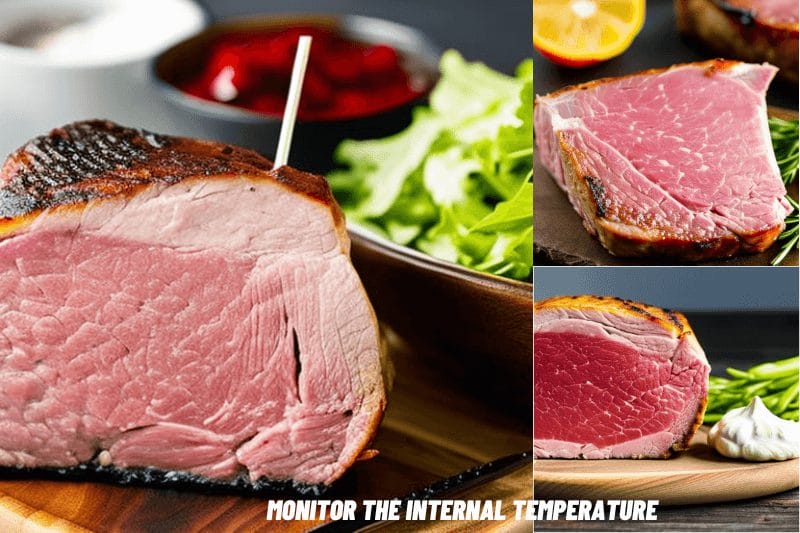
Monitor The Internal Temperature
Slowly and surely, monitoring the internal temperature of a pork shoulder is like listening to your heartbeat. It’s comforting yet nerve-wracking at the same time; if you get it right, you’ll be rewarded with succulent meat that will make all your guests happy.
To perfectly monitor the temperature and ensure that your pork shoulder turns out juicy and tender, here are four tips:
Making sure your pork shoulder reaches its desired temperature requires patience and dedication, but trust us – once you’ve mastered it, every bite will be worth it! So go ahead, grab yourself a reliable thermometer, then set aside some time for quality meat monitoring…Your taste buds (and tummy!) won’t regret it!
And now that we have our pork shoulder cooked through correctly let’s move on to slicing and serving up this delicious treat!
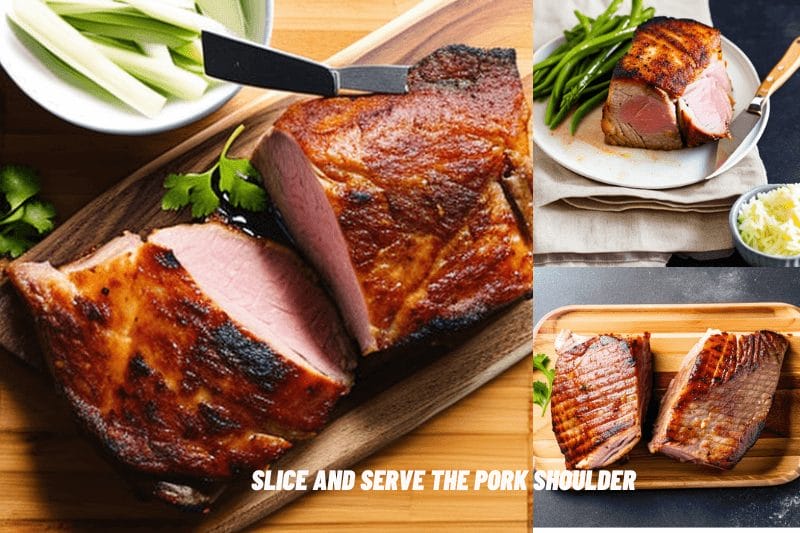
Slice And Serve The Pork Shoulder
Once the pork shoulder has been cooked to perfection and the internal temperature is just right, it’s time for that tantalizing final act: slicing and serving. Watching as flavorful juices drip down from each cut of succulent meat brings a feeling of satisfaction to any cook, whether experienced or novice. Now you can finally show off your culinary skills!
Taking a sharp knife in hand, angle it slightly downwards towards the grain of the pork to make sure each slice will be tender, not tough. Take care when removing excess fat from around the edges – this helps create an even more mouthwatering end product. With everything trimmed up perfectly, all that’s left to do is begin carving delectable slices of juicy goodness and transfer them onto plates.
A plate full of freshly-prepared pork shoulder with its enticing aroma wafting through the air is something no one can resist! The best part? Knowing that every bite will be bursting with flavor, thanks to all your hard work in prepping and cooking this delicious dish – a true labor of love for friends and family alike.
Conclusion
The perfect pork shoulder roast is within reach! With these five simple steps, it’s never been easier to create the most succulent and tender morsel of meat. All that’s left to do now is sit back, relax, and savor every bite.
But what about all those pesky rules? Don’t worry. We have a foolproof solution for you: just add more butter! We know it sounds crazy, but trust us – when it comes to roasting a pork shoulder, nothing rivals an extra helping of melted butter. The added fat helps keep the inside juicy while getting a crispy outer layer. Plus, your guests will be so impressed with the flavor they won’t even realize how little effort was put into making this meal.
So don’t fret if you think cooking something as complex as a pork shoulder roast is beyond your culinary skills. Now you can make restaurant-quality meals right in your own kitchen without breaking any of the “rules” – just remember one thing: always use extra butter!

